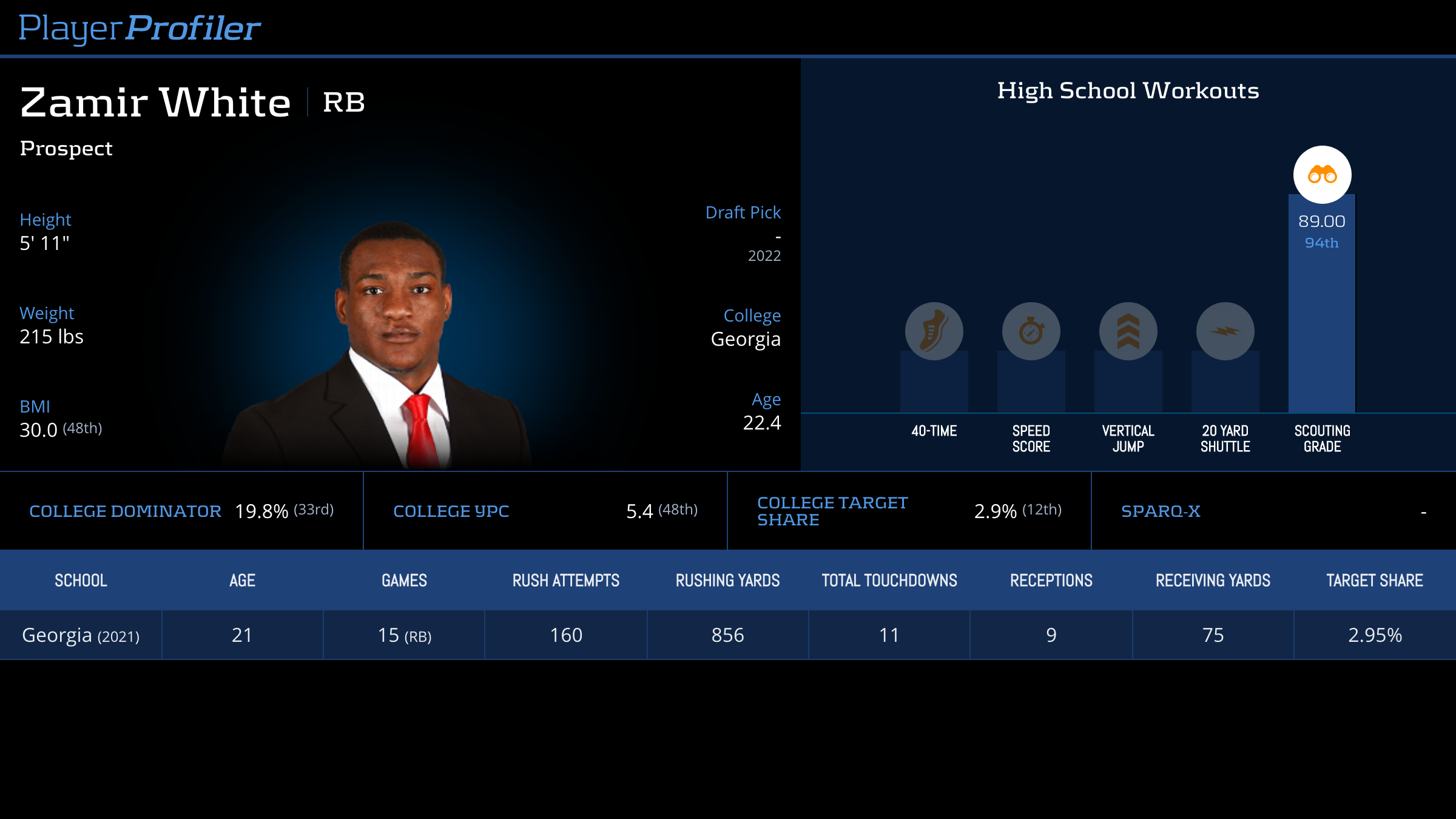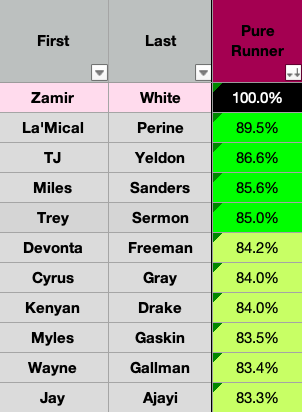This article is part of a series in which I evaluate 2022 rookie running backs solely on their ability to run the ball. The Breakout Finder installments can be found here. The four PlayerProfiler installments can be found here. If you happened to already catch those and don’t need a refresher on my methodology, feel free to skip to the player-focused analysis below.
The Player
Zamir White was a 5-star high school recruit with a bunch of hype coming into the start of his college career at Georgia in 2018. After an injury forced him to miss his entire true freshman season, he didn’t quite live up to the lofty expectations that his pedigree saddled him with.
The Metrics
Georgia might just be RBU. And the teammates that White shared a backfield with were pretty talented. A collective 4.01-star rating as recruits makes them an 88th-percentile group among RB teammates drafted since 2007. Relative to those teammates, his efficiency was less than stellar.
His career yards per carry average was 0.32 lower than theirs (19th-percentile). And his 10-yard run rate was 0.99-percent lower (31st-percentile). He also was not impressive in the open field. He converted 10-yard chunk gains into breakaway runs of 20 or more yards at just a 26.5-percent clip; a 33rd-percentile rate.
It’s Not All Bad
One point in White’s favor is that he typically ran in more difficult situations than other Bulldog backs faced. His average box count was 0.09 defenders heavier than theirs; a discrepancy in the 64th-percentile. White has good size. being listed at 6-0, 215-pounds last year. He doesn’t really catch passes, with 17 receptions in 37 career games. It makes sense that he would be carrying the ball against defensive fronts geared up to stop the run.
White actually was a significantly more effective runner than his teammates against heavy front. The average Zamir carry was worth 147.8-percent of the average non-Zamir carry against 8-man boxes, and worth 161.1-percent against 9-man boxes. He was outpaced by his teammates against all other box counts though. And while his aggregate Box-Adjusted Efficiency Rating is a positive 101.3-percent, that mark is bottom five in the class and a 17th-percentile showing.
Rushing Efficiency Score and Comps
According to my running back model’s composite Rushing Efficiency Score (which accounts for all the non-BAE metrics touched on here, in addition to rushing volume, overall team quality, strength of opponent, and offensive line play), Zamir White earns a 39.8 out of 100. That’s actually the same score he earns in a BAE-centric composite score that I’m currently workshopping. He faced heavy fronts while playing with talented teammates at a blue blood program. But giving him the benefit of the doubt simply requires a leap of faith that would border on irresponsibility.
My running back model also generates similarity scores between current and past prospects. Assuming White runs a 4.5 40-yard dash while measuring in at 217-pounds and just shy of 6-0 (a size projection made according to this research), the following players would be his most similar from a “pure runner” perspective (a comp made using the same metrics as the Rushing Efficiency Score, in addition to physical measurables):
I am genuinely shocked at the amount of relatively productive players on this list. Of these guys, only Jay Ajayi and Wayne Gallman had positive YPC+ marks in college. Ajayi did that against a group of running back teammates that averaged just 2.74 stars as high school recruits. And only Miles Sanders, Devonta Freeman, and Myles Gaskin had positive Chunk Rate+ marks. Really only Ajayi was an especially impressive college producer among these comps. Given that seven out of ten of them were selected in the fourth round or higher (and all of those guys came from powerhouse schools), I think the lesson here is that even mediocre players from top-tier programs receive opportunity in the NFL.
Last Word
Zamir White might be an actively good short-yardage runner. But I think that’s where the extent of his positive potential impact as a professional lies. He doesn’t catch passes. He failed to produce at a level becoming of a quality NFL back. And he wasn’t particularly efficient relative to his teammates. It’s entirely possible that a team looks at the “G” on his red helmet, sees a 5-star recruiting profile in the rearview, and decides he’s worth a role somewhere à la T.J. Yeldon or Karlos Williams. But I’m not the one to waterlog my dynasty rosters with draft capital-soaked sponge backs who are otherwise void of redeeming qualities.
You’re an adult now. You don’t have to consume the mystery meat that the NFL lunch ladies are serving you.




